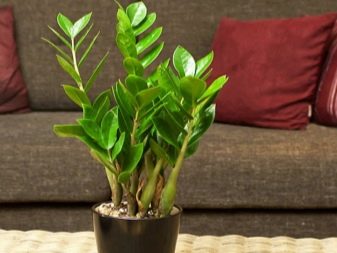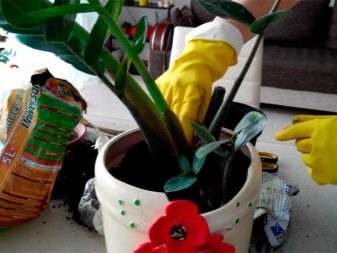How to choose a pot for zamiokulkas?

Zamiocalcus is one of the most popular indoor plants today. It was chosen by many flower growers because of its bright green foliage and massive stems. But for good growth and appearance of a dollar tree, careful maintenance, suitable soil, timely watering, lighting, and also a properly chosen pot are necessary.


Care features
This unpretentious plant requires good care. If you do not follow the following care features, the flower may get sick or die:
- lighting should not be bright, but the dollar tree does not like the shadow, which is why the flower tolerates partial shade best of all;
- in order for the plant to evenly release new shoots, it must be constantly turned towards the light source, especially in spring and summer;
- you need to water the zamiocalcus from above; do not flood the plant, as it does not tolerate excess moisture;


- spray the bush - in order to maintain a beautiful, bright green ground part, it is important to maintain high humidity;
- fertilize the flower in winter and spring, use a universal fertilizer for succulents - the dosage should be halved;
- transplant only when the plant becomes cramped in the old container;
- choose the right container for transplanting a dollar tree;
- if the bush has grown a lot, then carefully divide the tubers so as not to damage the root system.


The size
When choosing a pot for zamiocalcus, you need to be guided by several rules.
- When transplanting, the capacity should be slightly larger than the previous pot was. If the flower is transplanted into a pot that is too large, then the result will be no growth of the ground part until the root system grows over the entire pot.
- A deep pot is also not worth choosing, since it can hold more soil than the plant needs. In addition, more water is required in order to shed the soil, which can cause waterlogging of the root system and its decay.
- Consider the size of the plant. If the zamiocalcus has massive trunks that grow densely, it is better to purchase a wider pot. Adult plants have a well-developed root system, and tubers are usually large in size. Young plants have thin shoots with small tubers and a poorly developed rhizome. For such a flower, it is better to choose a flowerpot 1–2 cm wider than the diameter of the previous container.
- Choose a pot so that, in addition to the root system and soil, expanded clay will fit in it; the container should not be too low and wide.


The form
It is worth paying the necessary attention to the choice of the shape of the flowerpot for planting zamiokulkas, adhering to the following recommendations:
- the plant cannot be planted in a container with a narrow top, since the roots of the plant grow intensively, and the narrow neck of the flowerpot will complicate its next transplant;
- an excellent option for zamiokulkas would be the choice of a low pot;
- it is preferable to purchase a container in which the bottom will be narrower than the outlet, which is associated with the growth of the stems of the indoor plant.


Required model
To find the right pot model, there are several rules to follow.
- It is important not to forget that there must be drainage holes in the plant container. Excess moisture will be removed through them. There should be a lot of holes in the bottom of the container.In order for the plant to consume the correct water level, it is necessary to avoid stagnant liquid in the pot. To do this, it is best to pick up a flowerpot, at the bottom of which there will be large holes.
- The pot material can be either plastic or clay. It must be remembered that damaged plastic products produce harmful substances that can negatively affect the growth and health of the plant. Transplanting from a clay container is more difficult, since it is difficult to get a flower out of a pot, especially for inexperienced growers, often the root system is damaged.
The difference between the plastic container is that it can be cut in order to get the roots whole.


- Avoid purchasing a glass pot for zamiocalcus. In such a container, the soil will retain moisture for a long time. Do not forget that dry, well-ventilated soil is a favorable condition for the growth and development of this plant. Otherwise, due to excess moisture, the roots can be exposed to diseases and decay, which leads to the death of the plant.
- Pots made from peat and coconut fiber are commercially available. The advantage of such models is that the soil is well ventilated, and moisture does not stagnate, which leads to drying out of the soil. It is difficult for Zamiocalcus to tolerate not only wet soil, but also drought, which is its paradoxical feature.


Transplant tips
After acquiring zamiocalcus, you should not try to transplant it in the first two weeks, since the plant needs adaptation. Otherwise, the flower will experience double stress in the form of acclimatization and transplantation, which can subsequently lead to its death. Due to its slow growth, the dollar tree does not require frequent replanting. A young plant can be transplanted once every two years, and adults once every five years. Best of all, the flower tolerates this procedure in winter and spring.
In order to understand whether it is worth replanting zamiocalcus, you need to evaluate the filling of the old pot with roots. If the plant at the exit from the container has filled the entire space, it is best to cut the plastic pot in order not to injure the roots, or use the method of throwing the flower out of the container.
It is important to find the right soil. It should be loose so that the liquid seeps out easily. Succulent potting soil is suitable for the dollar tree.


A prerequisite for preventing root decay is expanded clay. It improves the drainage function of the soil, and also loosens it perfectly. After transplanting, do not moisten the soil too much. To begin with, it is better to let the plant get used to the new soil, and after that you can water and spray the flower in the usual way.
A properly selected pot for zamiocalcus and timely transplantation are the key to a healthy and beautiful plant that will delight you at any time of the year.


For information on how to transplant zamiokulkas, see the next video.













The comment was sent successfully.